We pump HP t5325 thin client
This article will focus on refining an HP thin client to install Debian 8 on it.
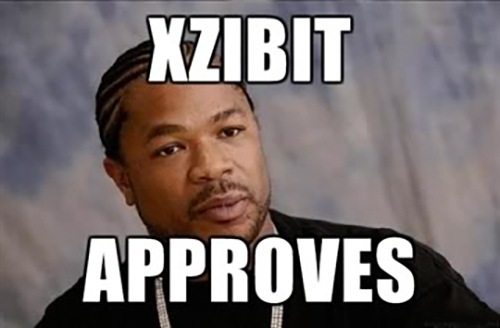
HP t5325 Thin Client is the smallest in its family and the only one built on the ARM architecture. Below are its main characteristics:
')
This client is powered by HP ThinPro, which is based on Debian. The problem is that the system is installed on the internal flash memory of 512MB. By modern standards, this volume is not enough for comfortable work, and the resource of rewriting cycles of the built-in Flash is small. Therefore, it was decided to install the OS on an external hard drive.
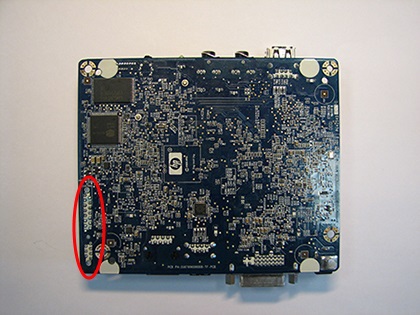
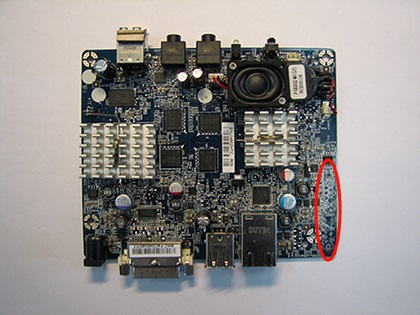
On the printed circuit board, you can see that there is space for installing a vertical SATA connector, but the dimensions of the case do not allow this. Also, on a more detailed study, it turned out that some elements are not soldered on the board, in particular, the filter capacitors on the Rx, Tx terminals of the SATA0 connector: C80, C81, C82, C83. The photo below shows their installation locations.
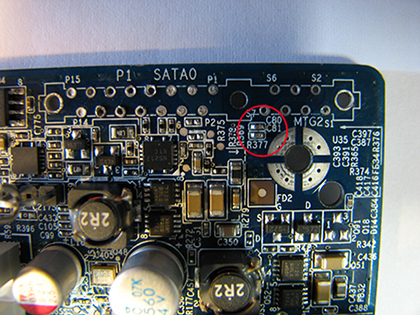

These capacitors can be borrowed from the board from the old hard drive:

After mounting the capacitors and studying the wiring of the board in the SATA connector area, the following connection scheme was determined:

Due to the lack of space inside the case, it was decided to install a hard drive on the outside, on the top cover. This provided convenient disk access and better cooling. For these purposes, a SATA cable from an HP DV5 laptop was purchased, it also fits DV6 and DV7-1000, it has enough length and a suitable diameter to fit through the holes in the top cover.
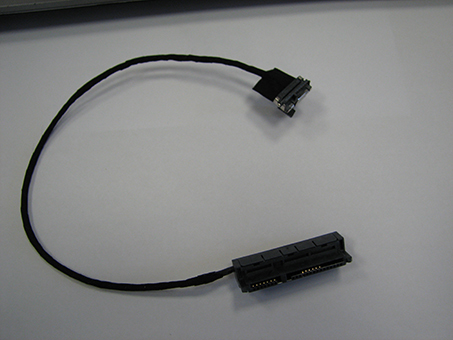
Next, remove the connector, determine the pinout and solder according to the scheme.
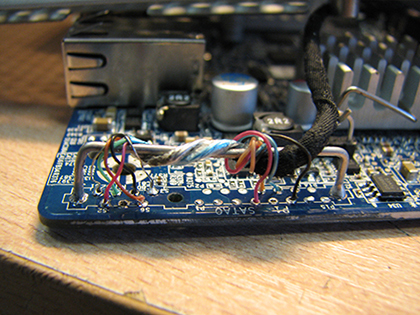

To increase the mechanical strength of the compound, fix everything with hot melt.
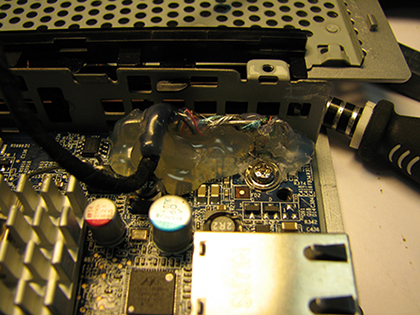
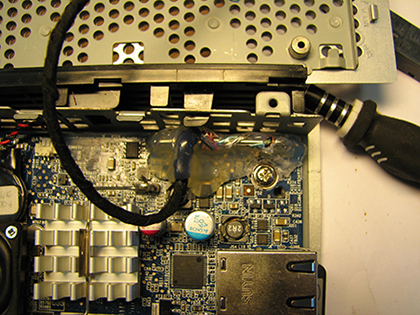
This thin client has no BIOS, it uses U-Boot to boot the OS. To configure the boot from an external drive, you need to access the U-Boot console; this can be done by connecting to the corresponding pins on the board, USB - UART converter.

Open Putty and select the COM port that is assigned to the converter. We supply power and quickly press the spacebar button until we see an invitation to enter commands.

In the U-Boot console, you must enter the following commands:
Here we expose booting from the hard disk (ide 1: 1), uImage and uInitrd will be loaded. The saveenv command means writing a configuration to non-volatile memory. More information about the available commands can be found by typing a question mark in the console.
Debian 8 was chosen as the OS as the most compatible and does not require additional doping. Before starting the installation, you must prepare the hard disk. On the disk, you need to create a single partition and format it into the ext2 file system, then copy to the root, uImage and uInitrd . Next, connect the hard drive to the thin client and apply power. If everything is done correctly, the system boot log should be displayed in the console and the installation should begin.

After successful installation, you need to log into the U-Boot console and make small changes to the config. If during the installation of the system the default disk partitioning was chosen and a separate disk partition was created for the boot folder, enter the following commands:
If everything is set in one section:
Everything! Now you have a mini Debian server that you can find a lot of applications at work and at home. Below are photos of what happened. The hard disk is mounted on the bolts from the VGA connector.




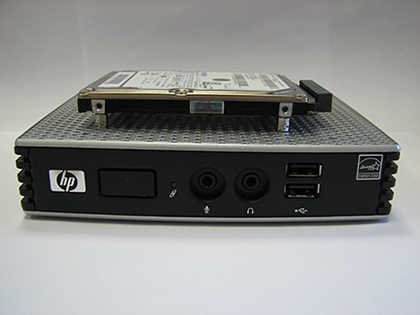
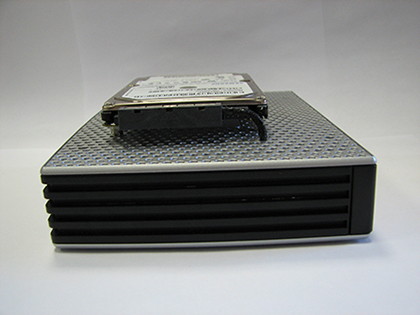

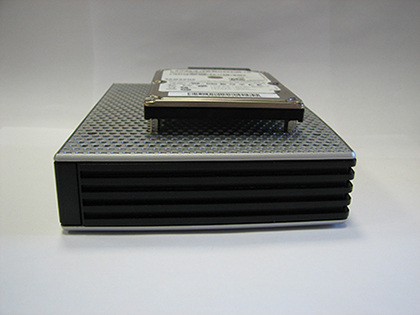
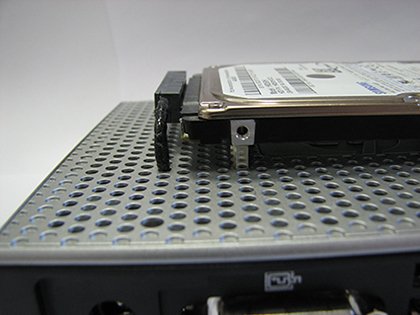
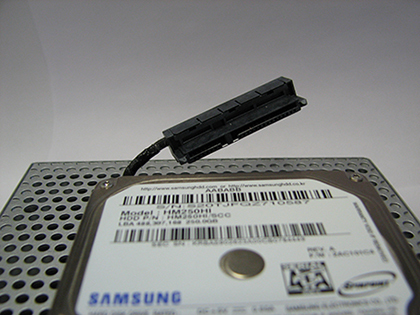
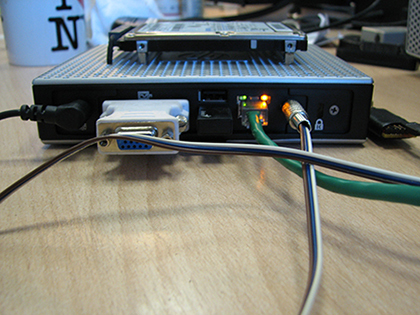


HP t5325 Thin Client is the smallest in its family and the only one built on the ARM architecture. Below are its main characteristics:
')
- Marvell ARM 88F6281 1.2 GHz processor.
- XGI VOLARI-Z11-A2CB-HF 64MB video card.
- RAM 512MB DDR2.
- Flash memory 512MB.
Training
This client is powered by HP ThinPro, which is based on Debian. The problem is that the system is installed on the internal flash memory of 512MB. By modern standards, this volume is not enough for comfortable work, and the resource of rewriting cycles of the built-in Flash is small. Therefore, it was decided to install the OS on an external hard drive.
On the printed circuit board, you can see that there is space for installing a vertical SATA connector, but the dimensions of the case do not allow this. Also, on a more detailed study, it turned out that some elements are not soldered on the board, in particular, the filter capacitors on the Rx, Tx terminals of the SATA0 connector: C80, C81, C82, C83. The photo below shows their installation locations.


These capacitors can be borrowed from the board from the old hard drive:

After mounting the capacitors and studying the wiring of the board in the SATA connector area, the following connection scheme was determined:

Due to the lack of space inside the case, it was decided to install a hard drive on the outside, on the top cover. This provided convenient disk access and better cooling. For these purposes, a SATA cable from an HP DV5 laptop was purchased, it also fits DV6 and DV7-1000, it has enough length and a suitable diameter to fit through the holes in the top cover.
Next, remove the connector, determine the pinout and solder according to the scheme.
To increase the mechanical strength of the compound, fix everything with hot melt.
This thin client has no BIOS, it uses U-Boot to boot the OS. To configure the boot from an external drive, you need to access the U-Boot console; this can be done by connecting to the corresponding pins on the board, USB - UART converter.

Open Putty and select the COM port that is assigned to the converter. We supply power and quickly press the spacebar button until we see an invitation to enter commands.

In the U-Boot console, you must enter the following commands:
setenv hdd_bootargs 'console=ttyS0,115200 root=/dev/sdb1 rw rootwait video=xgifb' setenv boot_hdd 'ext2load ide 1:1 0x800000 /uImage; ext2load ide 1:1 0x1100000 /uInitrd' setenv hdd 'ide reset; wol; setenv bootargs $(hdd_bootargs); run boot_hdd; bootm 0x800000 0x1100000' setenv mainlineLinux yes setenv arcNumber 2846 setenv bootcmd 'run hdd' saveenv Here we expose booting from the hard disk (ide 1: 1), uImage and uInitrd will be loaded. The saveenv command means writing a configuration to non-volatile memory. More information about the available commands can be found by typing a question mark in the console.
System installation
Debian 8 was chosen as the OS as the most compatible and does not require additional doping. Before starting the installation, you must prepare the hard disk. On the disk, you need to create a single partition and format it into the ext2 file system, then copy to the root, uImage and uInitrd . Next, connect the hard drive to the thin client and apply power. If everything is done correctly, the system boot log should be displayed in the console and the installation should begin.

After successful installation, you need to log into the U-Boot console and make small changes to the config. If during the installation of the system the default disk partitioning was chosen and a separate disk partition was created for the boot folder, enter the following commands:
setenv hdd_bootargs 'console=ttyS0,115200 root=/dev/sdb1 rw rootwait video=xgifb' setenv boot_hdd 'ide reset; ext2load ide 1:1 0x800000 /uImage; bootm 0x800000' setenv hdd 'setenv bootargs $(hdd_bootargs); run boot_hdd; bootm 0x800000' saveenv If everything is set in one section:
setenv hdd_bootargs 'console=ttyS0,115200 root=/dev/sdb1 rw rootwait video=xgifb' setenv boot_hdd 'ide reset; ext2load ide 1:1 0x800000 /boot/uImage; bootm 0x800000' setenv hdd 'setenv bootargs $(hdd_bootargs); run boot_hdd; bootm 0x800000' saveenv Everything! Now you have a mini Debian server that you can find a lot of applications at work and at home. Below are photos of what happened. The hard disk is mounted on the bolts from the VGA connector.




Source: https://habr.com/ru/post/260631/
All Articles